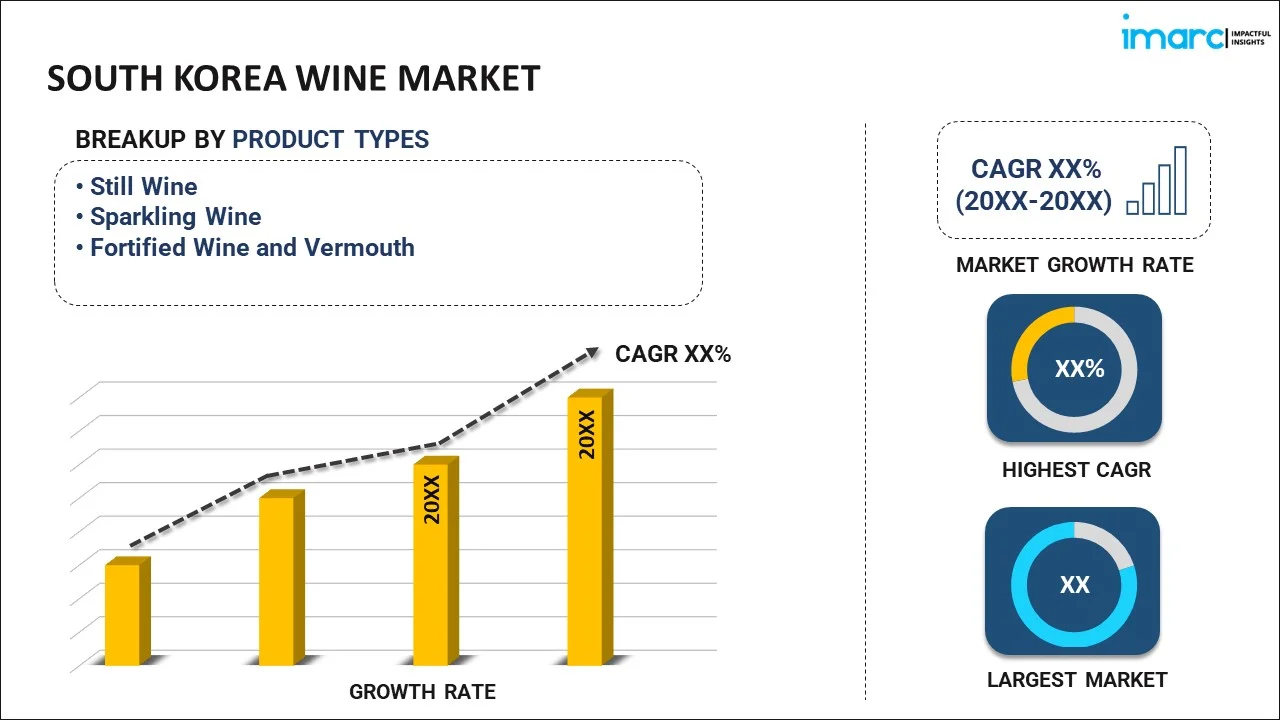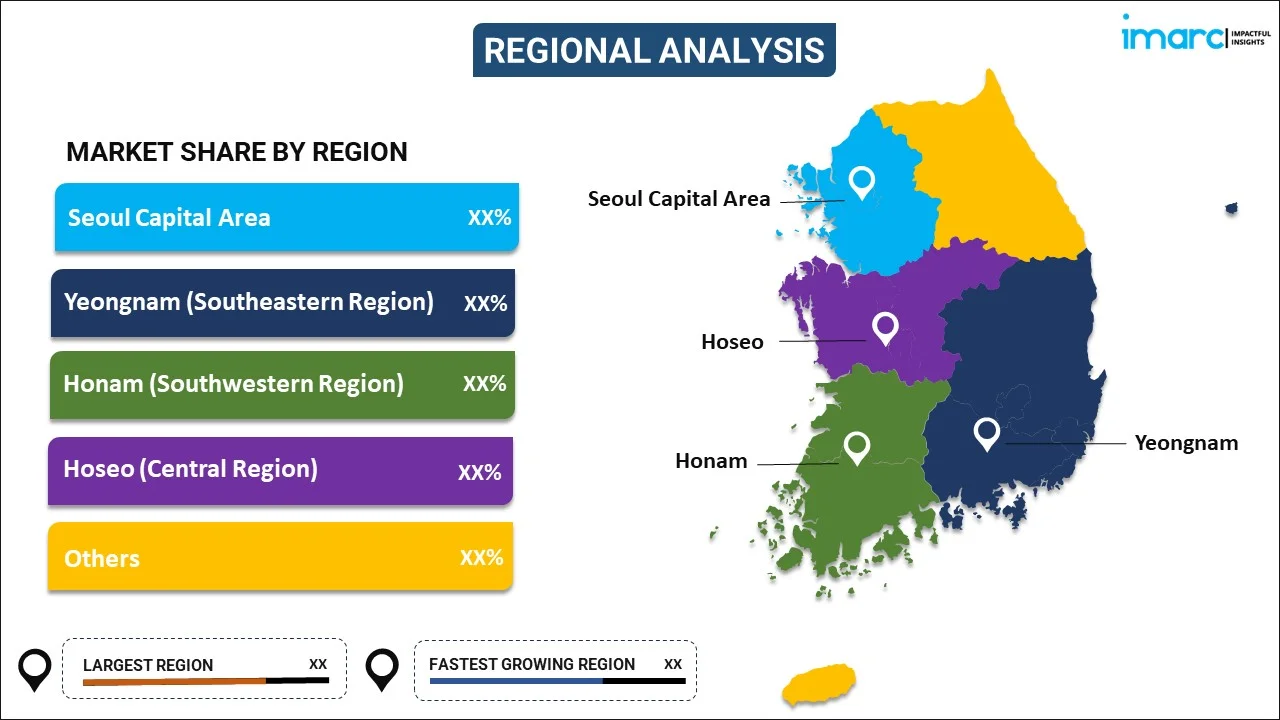
South Korea Wine Market Report by Product Type (Still Wine, Sparkling Wine, Fortified Wine and Vermouth), Color (Red Wine, Rose Wine, White Wine), Distribution Channel (Off-Trade, On-Trade), and Region 2024-2032
Market Overview:
South Korea wine market size is projected to exhibit a growth rate (CAGR) of 3.70% during 2024-2032. The increasing awareness of the potential health benefits of moderate wine consumption, such as antioxidants in red wine, is driving the market.
|
Report Attribute
|
Key Statistics
|
|---|---|
|
Base Year
|
2023 |
|
Forecast Years
|
2024-2032
|
|
Historical Years
|
2018-2023
|
| Market Growth Rate (2024-2032) | 3.70% |
Wine is an alcoholic beverage made from fermented grapes or other fruits. The natural chemical balance of grapes lets them ferment without the addition of sugars, acids, enzymes, or other nutrients. The process of winemaking involves crushing and fermenting the grapes with the help of naturally occurring yeasts. During fermentation, sugars in the grape juice are converted into alcohol. There are various types and styles of wine, which can be broadly categorized into red, white, and rose, depending on the color of the grapes used and the winemaking process. The flavor, aroma, and characteristics of a wine can also be influenced by factors such as the type of grape, the region where the grapes are grown (terroir), the winemaking techniques employed, and the aging process. Wine has been an integral part of many cultures throughout history and is often associated with social, religious, and cultural events. It is enjoyed for its diverse range of flavors, and people often pair different wines with specific foods to enhance the overall dining experience.
South Korea Wine Market Trends:
The regional wine market has experienced robust growth, fueled by a confluence of factors that underscore its resilience and adaptability. Firstly, the escalating consumer preference for premium and artisanal wines has been a pivotal driver, propelling the market to new heights. Additionally, the burgeoning popularity of wine as a lifestyle choice, coupled with increasing disposable incomes, has led to a surge in demand for diverse wine varieties. Furthermore, the advent of online platforms and e-commerce has transformed the distribution landscape, providing consumers with convenient access to a myriad of wine options. Concurrently, the growing trend of wine tourism has bolstered the market as consumers seek immersive experiences in vineyards and wineries. Technological advancements in viticulture and winemaking processes have also played a pivotal role in enhancing the quality and diversity of wines available in the market. In essence, these interconnected drivers paint a dynamic picture of the wine market's evolution in South Korea, positioning it as a thriving industry with a promising trajectory.
South Korea Wine Market Segmentation:
IMARC Group provides an analysis of the key trends in each segment of the market, along with forecasts at the country level for 2024-2032. Our report has categorized the market based on product type, color, and distribution channel.
Product Type Insights:

- Still Wine
- Sparkling Wine
- Fortified Wine and Vermouth
The report has provided a detailed breakup and analysis of the market based on the product type. This includes still wine, sparkling wine, and fortified wine and vermouth.
Color Insights:
- Red Wine
- Rose Wine
- White Wine
A detailed breakup and analysis of the market based on the color have also been provided in the report. This includes red wine, rose wine, and white wine.
Distribution Channel Insights:
- Off-Trade
- Supermarkets and Hypermarkets
- Specialty Stores
- Online Stores
- Others
- On-Trade
The report has provided a detailed breakup and analysis of the market based on the distribution channel. This includes off-trade (supermarkets and hypermarkets, specialty stores, online stores, and others) and on-trade.
Regional Insights:

- Seoul Capital Area
- Yeongnam (Southeastern Region)
- Honam (Southwestern Region)
- Hoseo (Central Region)
- Others
The report has also provided a comprehensive analysis of all the major regional markets, which include Seoul Capital Area, Yeongnam (Southeastern Region), Honam (Southwestern Region), Hoseo (Central Region) and Others.
Competitive Landscape:
The market research report has also provided a comprehensive analysis of the competitive landscape in the market. Competitive analysis such as market structure, key player positioning, top winning strategies, competitive dashboard, and company evaluation quadrant has been covered in the report. Also, detailed profiles of all major companies have been provided. Some of the key players include:
- Accolade Wines
- Bacardi Limited
- Pernod Ricard SA
(Please note that this is only a partial list of the key players, and the complete list is provided in the report.)
South Korea Wine Market Report Coverage:
| Report Features | Details |
|---|---|
| Base Year of the Analysis | 2023 |
| Historical Period | 2018-2023 |
| Forecast Period | 2024-2032 |
| Units | US$ Million |
| Scope of the Report | Exploration of Historical and Forecast Trends, Industry Catalysts and Challenges, Segment-Wise Historical and Predictive Market Assessment:
|
| Product Types Covered | Still Wine, Sparkling Wine, Fortified Wine and Vermouth |
| Colors Covered | Red Wine, Rose Wine, White Wine |
| Distribution Channels Covered |
|
| Regions Covered | Seoul Capital Area, Yeongnam (Southeastern Region), Honam (Southwestern Region), Hoseo (Central Region), Others |
| Companies Covered | Accolade Wines, Bacardi Limited, Pernod Ricard SA, etc. (Please note that this is only a partial list of the key players, and the complete list is provided in the report.) |
| Customization Scope | 10% Free Customization |
| Report Price and Purchase Option | Single User License: US$ 3699 Five User License: US$ 4699 Corporate License: US$ 5699 |
| Post-Sale Analyst Support | 10-12 Weeks |
| Delivery Format | PDF and Excel through Email (We can also provide the editable version of the report in PPT/Word format on special request) |
Key Questions Answered in This Report:
- How has the South Korea wine market performed so far and how will it perform in the coming years?
- What has been the impact of COVID-19 on the South Korea wine market?
- What is the breakup of the South Korea wine market on the basis of product type?
- What is the breakup of the South Korea wine market on the basis of color?
- What is the breakup of the South Korea wine market on the basis of distribution channel?
- What are the various stages in the value chain of the South Korea wine market?
- What are the key driving factors and challenges in the South Korea wine?
- What is the structure of the South Korea wine market and who are the key players?
- What is the degree of competition in the South Korea wine market?
Key Benefits for Stakeholders:
- IMARC’s industry report offers a comprehensive quantitative analysis of various market segments, historical and current market trends, market forecasts, and dynamics of the South Korea wine market from 2018-2032.
- The research report provides the latest information on the market drivers, challenges, and opportunities in the South Korea wine market.
- Porter's five forces analysis assist stakeholders in assessing the impact of new entrants, competitive rivalry, supplier power, buyer power, and the threat of substitution. It helps stakeholders to analyze the level of competition within the South Korea wine industry and its attractiveness.
- A competitive landscape allows stakeholders to understand their competitive environment and provides an insight into the current positions of key players in the market.
Need more help?
- Speak to our experienced analysts for insights on the current market scenarios.
- Include additional segments and countries to customize the report as per your requirement.
- Gain an unparalleled competitive advantage in your domain by understanding how to utilize the report and positively impacting your operations and revenue.
- For further assistance, please connect with our analysts.
 Inquire Before Buying
Inquire Before Buying
 Speak to an Analyst
Speak to an Analyst
 Request Brochure
Request Brochure
 Request Customization
Request Customization




.webp)




.webp)












